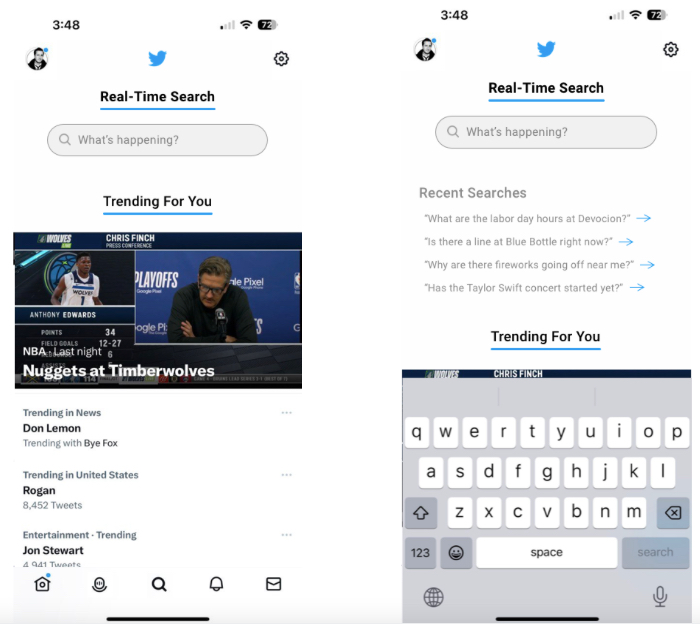
Real-time search. Google doesn’t have it. Neither does ChatGPT. Microsoft, Amazon, Apple, and Facebook probably wish they had it, but they don’t. Twitter, Silicon Valley’s favorite shitshow, is the only one with this power. And for some inexplicable reason, it’s not doing anything with it.
Twitter has a tremendous amount of live, real-time data about what’s happening where. This makes Twitter unique as a service—it encourages its users to create in-and-of-the-moment content. They share what they’re seeing, thinking, feeling, and experiencing now—for example, millions of people tweeting during the World Cup final, thousands posting about a Taylor Swift concert, or hundreds discussing an emergency in their town. Something happens, and seconds later, people turn to Twitter.
In contrast, Google (and search’s other new darlings ChatGPT/Bing) are moving at a snail’s pace. Google’s web crawlers can take anywhere from three to 30 days to cycle the internet fully. Its most “of the moment” results usually pull from news outlets, which themselves may take two to three hours to cover a significant event. And plenty of real-time topics you may want to search for will never warrant news coverage. “Why is the highway near me closed right now?” is a perfect example.
ChatGPT only accesses data from 2021 and earlier, according to OpenAI. It has no information about events taking place right now. It can brilliantly analyze any existing data you present to it, but it can’t use the internet for updates or developments (yet). AI like GPT-4 has a role to play in real-time search, but these computing systems need someone—or something—to feed it real-time data. Enter Twitter.
The data that Twitter is sitting on is truly unique. If it can figure out how to interpret it and serve it to users via search, it could be a game-changer. And yet Twitter search, even the advanced version, has barely changed in several years. It’s complicated, not particularly user-friendly, and not tremendously helpful unless you want to find a specific tweet from a specific account or look at a bunch of tweets from a lot of different people, many of which are either not relevant to your search or not reliable at all. It doesn’t help that they’re presented in no particular order.
Twitter Advanced Search has barely changed since its introduction in 2018. Its function is limited (you can’t search by tweet location, for example).
Twitter search could be so much better. In fact, it could be the best, most valuable part of Twitter. Right now it’s a purely functional feature that has received minor updates in 2012 and 2018. But, what if Twitter search did more than just help you quickly and easily find relevant tweets? What if it could analyze those tweets and provide an actual answer to the sorts of questions that can’t be answered by anyone else on the internet right now?
How it would work
The idea for Twitter’s real-time search originally came to me when I lived in the Flatiron neighborhood in Manhattan. It was September 2016. I had just walked into my apartment when my wife, standing by the window holding our dog, turned to me and said, “I think something bad just happened.”
She heard a loud bang and immediately ran to the window to see what was taking place. I was in the elevator, so I hadn’t heard anything. I looked outside to the famous line at Shake Shack right across the street from our building. Everyone seemed to be living their lives and enjoying their burgers. All seemed well in Madison Square Park until seven or eight cop cars raced down 23rd Street. Even that didn’t seem to faze those waiting in line.
I searched Google and found no information. I checked my local news and saw nothing. Finally, I went to Twitter and searched for “explosion + flatiron” and instantly came across several tweets about a bomb going off just a few blocks away from my building. This was the 2016 Chelsea Bombing, and in retrospect, a bunch of people eating at Shake Shack while a bomb went off may be the most New York City thing I’ve ever witnessed.
It took nearly two hours before major news outlets were saying anything about the bombing. Twitter was the only place I could go to learn more about what was happening near me. As helpful as Twitter search was then, it still served me tweets about “an explosion of new retail stores in Flatiron” and whether people’s laundry gear could spontaneously combust. Not exactly what I was looking for.
How would a better, more intelligent, real-time Twitter search work?
Mockup: The mockups above and throughout the rest of this article illustrate how real-time search on Twitter should look and function.
Almost all tweets contain the same valuable data: the text and media content of the tweet itself, who tweeted it, when they did so, and the current location of that author. Twitter also knows the type of device used to tweet, but this is less relevant for our purposes.
If I had access to real-time search on Twitter during the Chelsea bombing, I would’ve searched something like, “Was there an explosion near me?” Let’s break that query down to explore how Twitter could quickly parse tweet data to give me an accurate answer.
The Only Subscription
You Need to
Stay at the
Edge of AI
The essential toolkit for those shaping the future
"This might be the best value you
can get from an AI subscription."
- Jay S.
Join 100,000+ leaders, builders, and innovators

Email address
Already have an account? Sign in
What is included in a subscription?
Daily insights from AI pioneers + early access to powerful AI tools








Comments
Don't have an account? Sign up!